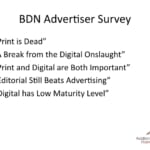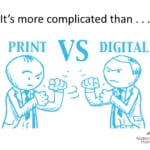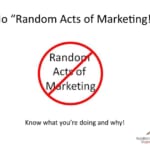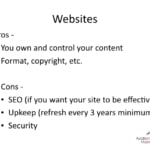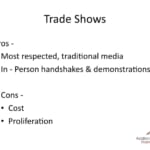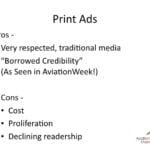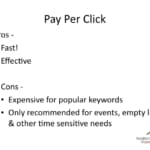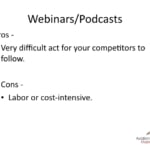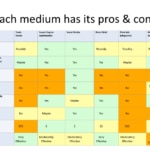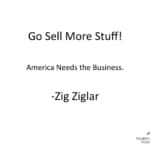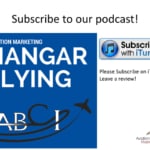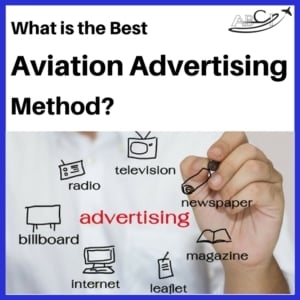 We’re often asked -“What is the best aviation advertising media?”
We’re often asked -“What is the best aviation advertising media?”
Although the short answer is – “whatever works best for the least amount of time and money invested,” the long answer depends on a number of factors, and the long answer is that this no one “best” advertising media, because none has all strengths and no weaknesses. The goal is usually to find the best COMBINATION of aviation advertising media that works best for your situation.
Many aviation sales and marketing professionals are frustrated with changes and shortcomings of different advertising media. They are looking for that one, perfect, trouble-free, cost effective advertising media that always works. The bad news? It doesn’t exist. The good news? You can find a perfect combination of advertising media that does the best job for you.
![]()
![]()
![]()
Transcript – What’s the Best Aviation Advertising Media?
Narrator: 00:00:08 You’re listening to aviation marketing Hangar Flying, the community for the best sales and marketing professionals in the aviation industry. You can’t learn to fly just from a book. You learn from other pilots, who know the tools, the skills and the territory. Your hosts, John and Paula Williams, are your sales and marketing test pilots.
They take the risks for you and share strategies, relevant examples, hacks, and how-tos. Be sure to subscribe on iTunes so you won’t miss a thing.
Paula Williams: Welcome to episode number 28. Today we’re going to be discussing, but probably not answering the question, what is the best advertising media for aviation, including international aviation advertising.
So I’m Paula Williams.
John Williams: I’m John Williams, and we’re ABCI. ABCI’s mission is:
Paula Williams: ABCI’s mission is to help aviation companies sell more of their products and services. So before we get started, I want to give a shout out to Phil Rouin who suggested that we use a hashtag to market our podcasts and our webinars.
So, if you want to respond to anything that we say in our podcast or webinars or anything else, you can use the #avgeekmarketing, and we will reply to every tweet. And with respect to Chris Clark, who had a great article in the AirFax Publication about why he hates the term avgeek, we understand that.
[LAUGH] And also David Parker Brown from Airline Reporter who says “I am an avgeek, and hear me roar!”John Williams: Well, I doubt we’ll be roaring, but.
Paula Williams: That’s true. No, there’s always controversy about any issue that is important enough to discuss. And it’s actually a pretty interesting conversation between the two of them.
If you want to look up both of those articles, you can Google them. Chris Clark’s point is that avgeek kind of demeans the profession, and David Parker Brown says, dang it, who cares, so?
John Williams: [LAUGH]
Paula Williams: The profession does not need us to defend it. [LAUGH]
John Williams: No.
Paula Williams: Exactly, all right, so what inspired this particular episode is an article in the New York Times that was about how some of the media websites were having trouble with faltering ad revenue and traffic.
John pointed this out to me, and we had a conversation about it. Because if you are in marketing or in any industry, you’re going to notice ups, downs, backwards and sideways all of the time. And it seems like it’s getting more frequent and more disruptive as technology changes and as Google changes its algorithm, as ad people used different software to determine how much they want to pay for ads.
So the question is, is digital marketing really such a great thing? Is print marketing really such a great thing and so on? Another thing that happened this week is VDM came out with there advertiser survey which is actually a really good document. I hope you grab a copy of that, that included verbatim quotes from the people that responded to their survey.
And among the highlighted things that people said, print is dead. Or print is a break from the digital onslaught. Or print and digital are both important [LAUGH]. Editorial still beats advertising. And by editorial they mean of course, articles, cartoons, anything that is not, that doesn’t look like a paid advertisement.
John Williams: Content is what-
Paula Williams: Content.
John Williams: The rest of us would call it.
Paula Williams: Exactly, digital has a low maturity level for the aviation industry. There were lots of really interesting comments from advertisers and from consumers of advertising in that survey that I think are definitely worth a read.
And if you are in this profession, you really need to understand what people are saying. And they did a great service by compiling all the information and making it available. That said, it is very contradictory and confusing. So what it really boils down to is, it’s more than just a fight between team print versus team digital.
But it is much more complicated than just a fight between good and evil, or light and dark, or whatever it is that you see your side and the other guy’s right?
John Williams: Well it shouldn’t be regarded as them versus us. It’s more logical this versus that.
Paula Williams: It is much more nuanced than that.
So today John and I played hooky in the middle of the day. And we got on the motorcycle, and we rode up the mountains a little ways from Tooele. It’s just a little town in Utah where we live, and you can go up the side of the mountain.
Then you can look down on this whole little town, see things a lot differently than you do everyday. When you’re in the middle of things, and you’re looking at the gophers in the yard, and you’re looking at the weeds behind the fence, and all of those other things, you kind of go nuts.
And what you really need to do when you’re thinking about your marketing strategy and everything else, is not think about the tasks you have to do this week. But you need to really back up a long ways, look at your whole business, look at your goals for the year, and look at what’s working for you and what’s not working for you and why.
So rather than just simply the way most people phrase their questions to us are very, very detailed and having to do with a very specific situation or a very specific task. And a lot of times it is really, really helpful to just take a break in the middle of the day, drive your motorcycle up in the mountains.
[LAUGH] And look down on your business, as it were, as a metaphor. And just go okay, here’s where we are, here’s what’s working. Here’s what may not be, and see things from the perspective of a larger point of view, right?John Williams: Absolutely.
Paula Williams: All right, okay, so the first rule of ABCI-
John Williams: [LAUGH]
Paula Williams: Our cardinal rule is “No random acts of marketing!” You really want to know what you’re doing and why. This is really important when you are choosing advertising media, and there’s a couple of other things to consider. One is that whenever you’re advertising using some third party media or some third party tool or anything else, you are essentially playing football on someone else’s field.
And this is actually a phrase that came up in an article by Cy Dawson, who was really, really frustrated because he had built an entire business on software that depended on Twitter which is one of the social media. And it was a great business, it had lots of software tools.
And it was really successful for a long time, but then they changed their terms of service and put him out of business. And in his parting comments, or his final article on his blog he said, you never want to play football on someone else’s field. And there is a lot of logic to that.
But there is another side to the story, and that is that you will never get very good at football if you’re only willing to play in your own yard, right?
John Williams: [LAUGH] Exactly.
Paula Williams: Okay, so it takes a variety of media to do great aviation advertising, some of which you control. And some of which are controlled by other people and entities who are going to change the rules on you.
And who are going to frustrate you and are going to raise prices on you, and going to do all kinds of crazy things that make you really frustrated and want to leave that media forever. But what you really need to do is consider the larger perspective.
John Williams: Well and sometimes you can’t leave the media such as Google, they change everything every day.
Paula Williams: Exactly well and there’s a lot of people who would love to leave google and just do things with paper only. And that is an option depending on your business but you certainly would pay a price for that.
John Williams: Yes.
Paula Williams: All right, so let’s talk about a few different advertising media and the pros and cons of each.
In no particular order we’re going to start with websites so this would be like your own backyard right? You learn to play football in your own yard which is not a bad thing because you control everything about it, you can turn on the lights, you can only play when the weather is good, you can do all kinds of wonderful things that you can’t do anywhere else because you control the format, you own the copyright to anything that you publish on the web as long as you put a copyright notice at the bottom of it.
You’re protected in a lot of ways. There’s a lot that you can do. You can control the colors, the fonts, the context, what’s on the right hand nav, what’s on your left hand menus, all of that stuff is within your control, assuming that you know how to do it, right? So it’s a great place to really control your aviation advertising.
[LAUGH] Or you have a web master that is working with you or you’re using a tool that is easy enough for you to manipulate yourself. So all of that is goodness. But the cons of that are that you have to keep up with a lot of technology, like for search engine optimization.We recommend at least twice a year that you have a search engine optimization company look at your website, evaluate the key words that you’re using, maybe do a SEO refresh to accommodate all of the changes that have happened to the search engines in the last. Weeks or months prior because they do changes things all the time on us don’t they John?
John Williams: Yes they do.
Paula Williams: Right the other thing is you want to refresh the underlying technology of your website we recommend doing a refresh of your design every three years at a minimum because technology changes. And also the styles of the times, the fashion in website themes and look and feel of website changes.
There’s new best practices and other kinds of things and you need to look like you’re up on the technology and you’re still in business. aviation advertising is competitive, so you need to keep up.
John Williams: Is this because I can wear shirts I wore in high school doesn’t mean I should wear them.
Paula Williams: Exactly.
John Williams: [LAUGH] Times have changed.
Paula Williams: Yeah, those things for men are not as different as things for women. Because men can still wear things that they wore a number of years ago. And they are vintage and cool and retro and all that other fun stuff.
John Williams: Mm-hm.
Paula Williams: Exactly. But you don’t necessarily want your web site to look vintage and cool and retro right.
John Williams: Yeah not three or four years old it just looks like you’ve ignored it.
Paula Williams: Right and then the other thing is security. You do have to have security software and or people looking at your website on a daily basis if you’re depending on it for your business.
Because things happen to websites no matter how well protected they are, hackers are sometimes one step ahead of you so you want to make sure that you have back ups and you’re able to restore from a back up whenever you have a situation where something’s been compromised or heaven forbid, hacked.
John Williams: And we’re not going in too much details on this We had what we thought was good security. And then our Google Analytics said going down, and our Lexis going down and we said, wait a minute. So we ran a cross-report and discovered that some people are using our domain name and [LAUGH] putting pharmacy adds out there.
And it was very very interesting how they did it once we had somebody else figure it out. But now we have security people that take a look at our site every day, week, month, year, and it’s relatively inexpensive but it’s one of those things. I mean, if you don’t know, you don’t know.
Paula Williams: Right. So there is some constant upkeep, just like if you have [LAUGH] with a yard, with an airplane, with anything else If you own it you’re responsible to keep it up. Otherwise it doesn’t do you any good at all, because it becomes out of service, out of date, out of repair.
John Williams: Yeah, I mean I’ve been around long enough to… I built this site from scratch using notepad for God’s sake. Tells you how long that was for a fortune hundred company. And now, of course, you wouldn’t do that from tons of reasons, but even, I thought I was fairly up to speed on security and we figured out how they did what they did it was going to take us way too much time to fix it so we hired people to do it.
Paula Williams: Absolutely right so that’s web sites that’s kind of like playing football in your own yard. The good news is you’re responsible for everything, the bad news is you’re responsible for everything.
John Williams: [LAUGH].
Paula Williams: Okay. Trade shows are the most respected, most traditional media in aviation advertising. You can have in person handshakes and demonstrations.
You can do that anywhere else. So trade shows are a great place to meet a lot of people at the same time with only one air plane ticket right. So that’s a wonderful thing but there is a problem with trade shows in that they are proliferating. It used to be that there were four or five major trade shows that Everybody went to, and if you went to those four or five pages every year, you would hit the major players.
You’d be able to meet with everyone in your market, basically cover all of your bases with the people that you wanted to meet with. In the last ten years though, the number of trade shows have proliferated to the point where there are hundreds of trade shows every year, just in the United States even.
If you look world wide there’s probably thousands of trade shows on different topics and different specialties and different geographic areas and things like that. So they have proliferated a lot and also the cost of doing these trade shows has gone up quite a bit. Just in the years that we’ve been Appearing at trade shows.
Booth rent has gone up, they charge for everything. They charge for cleaning your carpets in between days. They charge for a garbage can.
John Williams: That’s right, for the garbage can and to empty it.
Paula Williams: Exactly.
John Williams: [INAUDIBLE] charge.
Paula Williams: [LAUGH] They charge for internet. There’s ways around that.
You can bring your own sometimes.
John Williams: [LAUGH] They charge for electricity.
Paula Williams: They charge for electricity, anything that they can charge you for. It seems like every year the costs go up. Maybe 10%, or.
John Williams: And then they charge you for an extra chair.
Paula Williams: Exactly. It does take a bigger bite out of your budget than it used to, which is.
So, print ads, the next media we’re going to talk about, in magazines and other kinds of things. So the pros are, they are also very respected, very traditional media. You can borrow the credibility of the magazine of you have placed an ad in aviation week then you can put an aviation week logo on your website and say this product is as seen in aviation week.
And there is a lot to be said for that especially for some newer products that don’t have the name recognition, and you know that comes from an older brand and things like that. So It does it gives them psychological weight, gravitas, to maybe a new brand or a start up or something like that.
The cons of print ads in magazines are once again, proliferation. There used to be four or five magazines that everybody would read, and now there are hundreds of magazines. If you go to NBAA and look at the literature racks, you will see at least 30, I would say, magazines that you can just pick up a copy of every single one of them and if you are able to carry them home. And if you’re talking international aviation advertising, that number goes up exponentially.
John Williams: And those are the ones, they selected to have in the convention, there are more.
Paula Williams: Right, so the number of magazines has really proliferated. Most of the individual magazines, I should say, have had declining readership in recent years where people are either going to a digital version or not taking that magazine at all because they are getting their information in other ways.
Readership is declining. Cost has not declined in proportion to that proliferation and that declining readership, so you’re not getting as good of a deal for print ads as you used to. But it still is sometimes worth it for that borrowed creditability and that respect and being in that very traditional media.
John Williams: And as a number of magazines have proliferated, the amount of time people have to read them has gone down.
Paula Williams: Right. So they read them faster. [LAUGH] If they read them at all.
John Williams: Yeah. If they read them at all.
Paula Williams: Okay. Pay per click, getting into one of the digital media.
The pros of pay per click are that it is very, very fast. You can create a pay per click ad in 15 minutes if you know what you are doing and have it all over the Internet, internationally. There is no other way, that I know of, to make that happen that quickly.
It is also very effective for a particular keyword. If you do a really effective campaign and you’ve thought it out and you do it very carefully, that can get some really great response for a pay-per-click ad.
John Williams: That pre-supposes effectiveness is that you’ve chosen the correct key word or key phrase.
Paula Williams: That’s why you need somebody who knows what they’re doing, because you have to do the research to get everything right in order to make them effective. They are very nerdy, we don’t recommend that the casual observer try and place a paper quick ad. It’s gotten a lot more technical than it used to be, and there’s a lot more people competing in that market.
John Williams: And it’s more expensive and it’s a good way to lose a lot of money and get nothing out of it.
Paula Williams: Right. So, since January, they have cut the number of pay per click spaces, at least, for Google ad-wares, which is the most popular paper click venue. They used to have Google ad words at the top of the search page, and on the side of the search page on the right hand side.
But they’ve gotten rid of those results on the right hand side. So they have half as many advertising spaces, and are charging the same amount for them, or actually charging more for them, because they have the same number of spaces. So you have to bid more to compete with the same number of spaces.
So the cons are that they can be very expensive for popular key words. And we only recommend them for things like empty legs or events or other things that you absolutely need to advertise right away and there’s other way to meet your time objectives with other advertizing. All right.
LinkedIn a social media that is not considered a social media by those who hate social media,right? [LAUGH] You talk with a lot of aviation executives and they will tell you, I don’t use social media or I don’t believe in social media, but then you ask them do you have a LinkedIn profile, and they’ll say, sure I have a LinkedIn profile.
That’s different, somehow it ends up being in a different category than the other social media so the reputation of LinkedIn is better. So of the social media, I’d say it’s probably the most respected, would you agree John?
John Williams: Yes, depending on what you’re after.
Paula Williams: Yeah John is one of those that does not do social media but does have a LinkedIn account.
John Williams: Watch it now.
Paula Williams: [LAUGH] Right okay, so it’s great for reaching professionals and business contacts but the cons are that their advertising tools are not as sophisticated as some of the other social media, particularly Facebook, which is probably the gold standard as far as their advertising options.
You know the ability to choose a campaign to reach a particular group of people that has particular behaviors and preferences and other known attributes that you really want to target. For international aviation advertising, this is pretty specific and helpful as well.
John Williams: You can really refine the demographics of what your looking for.
Paula Williams: Exactly, so LinkedIn is not quite that good, but it certainly is more respectable.
Facebook, if you look at the pros of Facebook numbers, this is the largest audience that you can get even of the aviation demographic. Especially for general aviation and some of the recreational aviation. It can be very effective, they have very low cost advertising options, and very granular campaign options.
Where you can target specific behaviors, characteristics, and re-targeting of people who like a particular page, or like a particular company. Or have a particular behavior. Maybe they have purchased a home in the last year, or purchased a car in the last year. You can find that out on Facebook, and you can’t anywhere else.
So it’s just scary, the number of things that you can’t target, very specifically using Facebook.
John Williams: That’s going to be like big data, right?
Paula Williams: Big data.
John Williams: [LAUGH]
Paula Williams: Yeah, and you don’t have to be a big company. This is one of the ways that are very small company can take advantage of big data because they collect it, they manage it, they give you a nice little dashboard, by which you can do this.
It is kind of nerdy. So it is something that I wouldn’t recommend doing a large campaign yourself until you either get some training, or get someone to do this for you.
John Williams: And watch them do it the first time.
Paula Williams: Exactly. So, the cons of Facebook is that it’s not seen as credible by some in the aviation industry.
There are a few, I’d say maybe half, of the decision makers in aviation who are older, they tend to be 40 plus, they tend to be male, they tend to be former military, they tend to have security concerns and other kinds of things. About half of that group, and I’m going to call them the aviation decision maker demographic, feel a little weird about Facebook.
John Williams: They won’t admit they use it, even though they do.
Paula Williams: [LAUGH] Right, but lot of those people have been dragged into Facebook, kicking and screaming by their grandchildren. And started to use it as users. And so lot of those folks, and that’s why I’m saying half. So half would not touch it, half have been dragging, kicking and screaming into that world.
All right.
John Williams: But nonetheless, that means they’re there so when you do re-targeting, they’re going to see it.
Paula Williams: Exactly. True, that’s as users, not necessarily as advertisers. Yeah. Okay, so video and YouTube. So when we are talking about videos on YouTube, we’re talking about two things. One could be live video, where you stick a camera in front of somebody and take video, the other thing could be slides with background music or voiceover made into a video file.
Right? Either of those two things fits into the category that we’re calling video or YouTube. Fair?
John Williams: Sure.
Paula Williams: Okay, great. So this category is great for product demos, facility tours, explanation of complex concepts, introducing employees, especially your sales people or customer service folks where you want to profile somebody and make it look like, make people feel more familiar with the particular person.
So that they feel more comfortable picking up the phone and talking to that person. It’s a very effective way to make a connection with a perspective customer. These are often also shared between people so somebody at a company sees something they like, they will pass it to a colleague or coworker or boss.
And say have a look at this and tell me what you think. So, it’s more likely to be virally spread than a lot of other media. The con’s of video or YouTube are that it is labor intensive or cost intensive, if you’re hiring someone else to do it to produce good video.
John Williams: Well define good. If you mean broadcast video, which you don’t need, yes it’s extremely expensive.
Paula Williams: Right. But even YouTube quality video, you do need to shoot it, you need to edit, you need to put it together, you need to upload it, you need to put the key words on it.
All of those things.
John Williams: But you’re talking 1,000s versus 100,000s different.
Paula Williams: Yeah. Absolutely. You can produce a fairly decent video that is effective, that is not necessarily studio quality and polished for 100s, or 1,000s of dollars as opposed to 100,000s of dollars.
John Williams: Right.
Paula Williams: That video used to cost, right.
Okay moving right along, webinars and podcasts. One of the really great things about this we were actually just talking with a client yesterday about this. If you have a competitor that copies everything you do, this is a great antidote for that, because if you do a webinar or a podcast it is an incredibly difficult act for your competitor to follow.
Even if they did the same topics and everything else they are not you, so they can’t replicate the same personality and the same style that you have. And if you’re occupying that space first, they are very unlikely to follow you Into that space.
John Williams: [LAUGH]
Paula Williams: They’d be crazy to follow us in here, right?
John Williams: That’s right.
Paula Williams: And that’s the cons, it is labor or cost intensive to do a regular webinar series or a podcast. So either you have to hire somebody to do that for you or you have to do it yourself. And it is pretty labor cost intensive to do a good one.
John Williams: We were dragged kicking and screaming into creating [LAUGH] an audio video studio so that we could do all this stuff.
Paula Williams: Exactly, this is not where we expected to be, but it is so effective that now we’re recommending it. All right. So every medium has it’s pro’s and con’s and the moral of this story really is that there is no one medium and everybody is always asking us, they tell us I’m really frustrated with this particular medium, I don’t want to do it anymore, I want to do something else, what should I do so I don’t have these problems?
And the answer is everything has its problems, everything has its pros and cons. So.
John Williams: It depends on your target market.
Paula Williams: Exactly, so what we really need to do is sit down and have a look at your objectives and what media you’re using now, and then cover the weaknesses And multiply the strengths of what you’re doing now.
So if you look at a chart that shows the pros and cons, and there’s one that you can see in the show notes for this session. And we just picked a couple of things like trade shows, search engine optimization, social media in general, direct mail, print ads, directory ads. In the U.S., and for international aviation advertising. What are the pros and cons of each?
And you’ll notice if you look down those columns, there is none that is perfect. The ones that are really good at one thing will not be so good at another attribute. So you really want to cover your bases and you also want to make sure that you are playing football on your own field and you’re also playing football on other people’s fields.
If somebody changes the rules on you so that you can’t play on a particular field no problem, you’ve got plenty of other places to play all right.
John Williams: And if you’re in a car you’re not going to see this anyway.
Paula Williams: [LAUGH] Exactly. Right. So the other thing is you want to, when you create materials, advertising materials, articles, videos, content whatever advertising materials you create, you want to think about being able to deploy them in more that one format.
So as an example, we do this podcast, we have a transcript of this podcast created, we post it on our website. We post little chunks of it on social media. We publish it on iTunes as a podcast. We use bits and pieces in some of our webinars and things like that.
Some of this is going to end up in our printed newsletter, which gets sent to people in the mail on paper made from trees using varial technology. So when you think about creating material you want to create things that are versatile enough that you can turn it into multiple forms of advertising without a whole lot of work.
John Williams: Instead of starting it on Twitter and have them change things you started it on your website.
Paula Williams: Hm-mm.
John Williams: You’ve diversified and split it out where if they change things on one social media you don’t care because you’re everywhere else anyway.
Paula Williams: Absolutely, so if Twitter goes away tomorrow or Instagram disappears or LinkedIn changes its rules or your favorite magazine raises its prices so that it’s out of reach, or your favorite trade show has a hurricane and doesn’t have a show that year, there’s lot of things that can happen.
And if you have multiple venues of advertising, diversity really equals stability, right? And when we did our prospecting webinar, we used the example of a little kid fishing for the first time is going to dip a line in the water, and be just absolutely thrilled if he caches a fish.
But he has one line, and he caches one fish at a time, which is great. But if you are in business, you really can’t depend on that one line. You really want to have multiple lines. And we use the example of a trolling boat. That has multiple line in the water at any given time and is using multiple kinds of bait, multiple lengths of lines, other types of things so that they are diversifying their angle of attack here [LAUGH] and making a different approach to all of the different fishes.
Some of the them are going to like one things better than another and you have a much better chance of having a stable business if you’re not dependent of any one line producing a fish. So, download our tip sheet, the tip sheet this week is our design brief template.
We offered that to people that came to our free branding webinar. But this is a really great way to think about using your materials in more than one way. So your webinar should be branded, your podcast should be branded, your Twitter, tweets should be branded. Your Facebook posts and so on.
All of those should be branded in a way that makes it clearly identifiable as your material and that’s a really good way to diversify across those things. So.
John Williams: A good quote to end on. Go sell more stuff, America needs the business. Guess who said that. I gave you five seconds.
You’re probably wrong, but Zig Zeggler.
Paula Williams: [LAUGH] Exactly, I think we have that away, last week, but that’s okay. If you didn’t get it, or if you forgot, that is a really good quote to remember. In fact, you should print that out and stick it on your wall, if you’re in business.
John Williams: And, the reason that works is because the multiplier effect in a capitalist market.
Paula Williams: Absolutely, every dollar you make is more than a dollar added to the economy which is a wonderful thing. All right so subscribe to our podcast, subscribe on iTunes, Stitcher or now on Google Play and leave us a review.
John Williams: And we’ll see you next time.
Narrator: 00:35:17 Thanks for joining us for aviation marketing Hangar Flying. The best place to learn what really works in sales and marketing in the aviation industry.
Remember to subscribe on iTunes and leave a rating.
[MUSIC]
For more about Aviation Advertising:
How to Get Testimonials for Aviation Advertising!
What’s the best Aviation Advertising Media?
“Aviation Advertising – Don’t Abandon Tradition, Build On It!
Buying Advertising for Aviation Products and Services
Seven Ways to Use Postcards in Aviation Advertising
How to Get Testimonials for Aviation Advertising!
What’s the best Aviation Advertising Media?
Aviation Advertising – Don’t Abandon Tradition, Build On It!
Buying Advertising for Aviation Products and Services
Advertising & Prospecting Basics
Brand Advertising versus Direct Response Advertising
Aviation Advertising – Create a Checklist to Help Your Prospects
Presenting Your Offer – AKA – Your Advertisement
Free Webinar – Convincing Prospects and Customers with Visual Data in Aviation Advertising[/fusion_builder_column][/fusion_builder_row][/fusion_builder_container]




